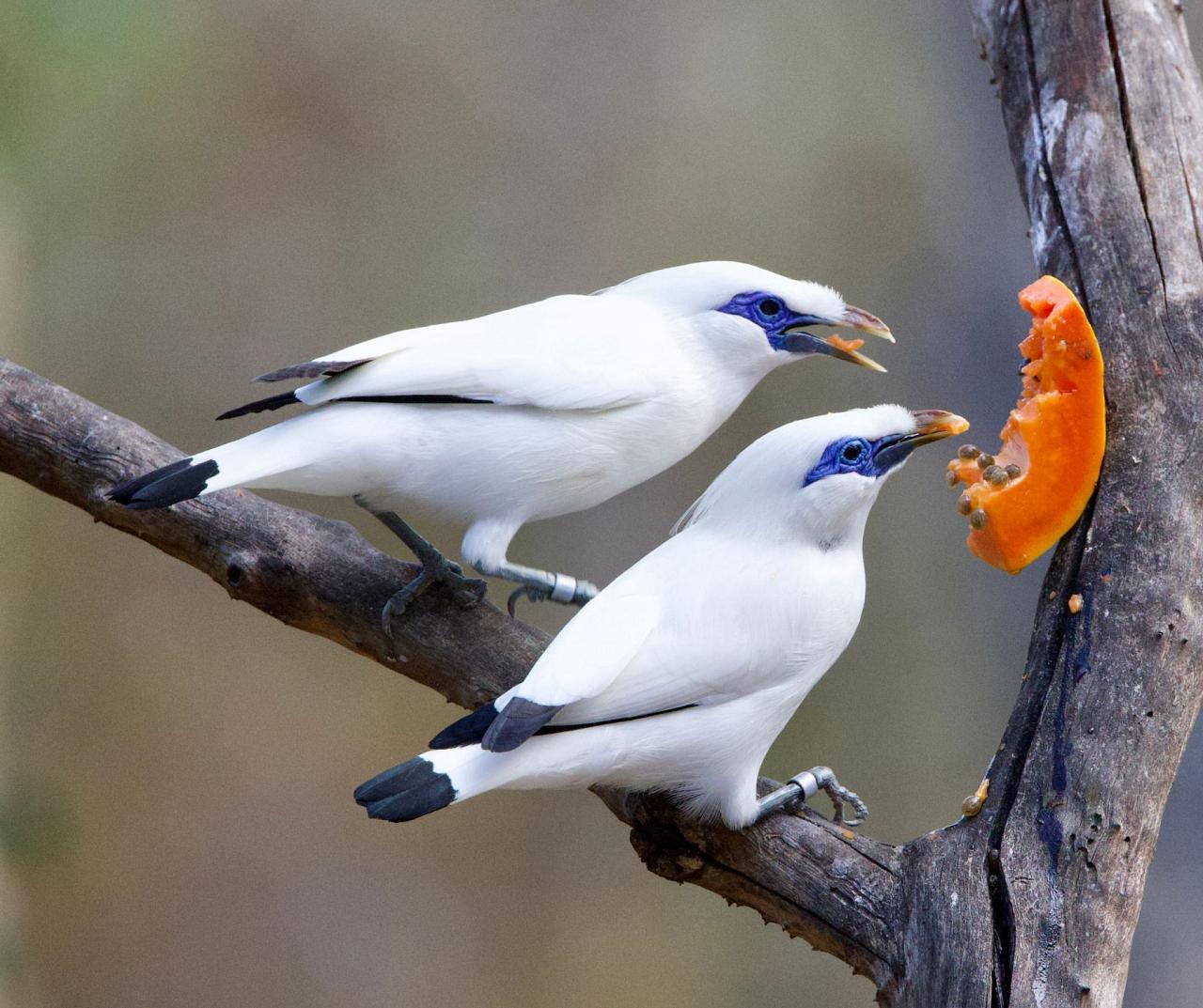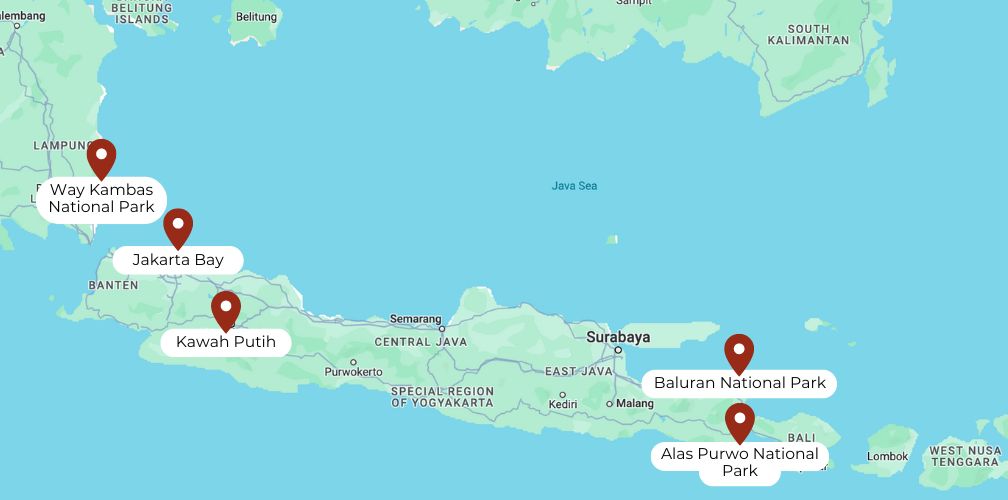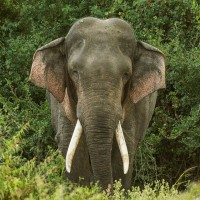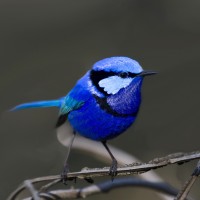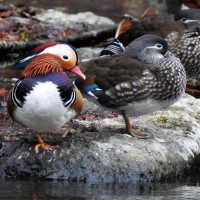- Overview
- Full Itinerary
- Photo Gallery
- Costing
- Travel Details
- Trip Reports
- Guide
- Map
- Know Before You Go
- Other Trips You May Like
Join Naturalist Journeys on this bird-filled and enlightening adventure to Indonesia, where we seek out the endemic species of the region including many of the most colourful and jewel-like birds with our trusted Southeast Asia expert, Nick Upton. This year, we've added two extra days to slow down and savor the birds.
Visit Way Kambas National Park for specialities like Malayan Banded Pitta and Rufous-collared Kingfisher as well as some of the best night birding in Asia. Look for endangered Milky Stork and Christmas Island Frigatebird as well as many other waterbirds in the urban environment of Jakarta Bay. Visit the mountains of Gunung Gede and the volcanic crater of Kawah Putih in West Java for rare endemic species including Javan Trogon, Javan Hawk Eagle and Chestnut-bellied Partridge. Spend a morning around Cibodas Botanical Gardens in search of Yellow-throated Hanging Parrot. Visit Baluranm Gunung Ijen and Alas Purwo National Parks in East Java where birds such as Green Peafowl, Lesser Adjutant and Asian Woolly-necked Stork can be seen in savanna-like habitat and gems including White-faced Partridge and Javan Banded Pitta can be seen at close-quarters from a hide. Finally, travel to the famous island of Bali where the stunning Bali Myna is making a remarkable recovery in one of the region’s most heartening conservation stories.
- “Our leader, Nick Upton, did an excellent job overall. His skill at getting the telescope onto a bird and letting us get at good look at the bird was amazing. Birding at Alas Purwo National Park was great. The Green Peafowl in the field with several mammals and other birds made me think of the plains in Africa. This was easy birding at its best.” — Robert Leonhardt, 2023 Traveler
- “A great adventure! Obviously some challenges, but well worth the effort. Top highlight: The birds!! Observing and learning about the many fantastic bird species of Sumatra, Java and Bali.” — David Ward, 2023 Traveler
Tour Highlights
- Explore Way Kambas National Park for Malayan Banded Pitta, broadbills, exceptional night birds and a myriad of woodpeckers
- Cruise Jakarta Bay for Milky Stork and Christmas Island Frigatebird in a unique urban-birding experience
- Visit Cibodas Botanical Gardens with lovely views of the volcanic peaks that form Gunung Gede-Pangrango National Park and the chance to see Sunda Thrush among many other birds
- Look for the super cute Pygmy Cupwing and a wide variety of Javan endemics including Chestnut-bellied Partridge and Rufous-tailed Fantail
- Visit Alas Purwo National Park where views over savanna-like habitat provide superb views of Green Peafowl, gem-like Javan Kingfisher and the prehistoric Lesser Adjutant
- The jewel-like Javan Banded Pitta could just be bird of the trip here. Mammals such as Banteng and Sunda Sambar are common too
- Search the slopes of Gunung Ijen for the stunning Pink-headed Fruit Dove and enjoy a wonderful performance from endemic White-faced Partridges
- Enjoy a late afternoon and early morning at Baluran National Park where Green Junglefowl, Black-winged Myna and Asian Woolly-necked Stork come to drink and feed at waterholes
- Take in Bali Barat National Park where the unique Bali Myna is now expanding from
Trip Itinerary
Itineraries are guidelines; variations in itinerary may occur to account for weather, road conditions, closures, etc. and to maximize your experience.
Wed., Sept. 9 Arrivals
Welcome to Indonesia! Please plan to arrive no later than midday today. We get together for dinner tonight at 6.30pm in the hotel restaurant. We have a pre-trip briefing, get to know each other and our guide, and prepare for the grand trip to come.
Accommodation at Orchardz Hotel Jakarta Airport (D)
Thurs., Sept. 10 Bandar Lampung, Sumatra | Satwa Lodge Way Kambas National Park
After an early breakfast at our hotel we take a quick 50-minute flight from Jakarta to the city of Bandar Lampung in southern Sumatra where we are met by our drivers and local guide for the next five days. The two-hour drive to Satwa Lodge takes us through the outskirts of Bandar Lampung then through rice fields and villages before we arrive in time to check in and have lunch at our lodge.
After settling in we head out for a late afternoon birding session where we try to find some of the star birds for a big start to our trip; Malayan Banded Pitta and White-winged Duck are both birds that we have a good chance of finding on our first day. This evening we stay out for some night birding; Way Kambas is one of the best locations for this activity in Southeast Asia. The incredible Large Frogmouth and Bonaparte’s Nightjar are both species that we can expect to find.
Accommodation at Satwa Lodge, Way Kambas (B,L,D)
Fri., Sept. 11 & Sat. Sept. 12 Exploring Way Kambas National Park
We have two full days to enjoy some of the best lowland birding that Southeast Asia has to offer. As the previous evening should have demonstrated, for anyone who enjoys night birding this is a must-visit location and we have the time to make a couple of evening excursions to look for birds such as Sunda Frogmouth, Malaysian Eared Nightjar, Brown Boobook, Reddish Scops Owl, Sunda Scops Owl, Gould’s Frogmouth, and Large-tailed Nightjar with the crowning glory being Oriental Bay Owl. A high level of success is usually enjoyed with these birds but patience and a little persistence is always needed; at least one of these birds has the knack of making life a bit hard on each trip.
The quality forest here is home to a wide range of species that are rare in much of their range but here the ground-dwelling Crested Fireback is fairly abundant and if we are lucky we have a chance of locating parties of amazing Crested Partridge or even Great Argus. Malayan Banded Pitta is a jewel of the forest floor and we have time to make every effort to ensure everyone gets a good view of this stunner. Woodpeckers are well-represented at Way Kambas and we are likely to see many species including Olive-backed Woodpecker, Buff-necked Woodpecker, Orange-backed Woodpecker, White-bellied Woodpecker, Banded Woodpecker, and Buff-necked Woodpecker as well as the tiny, hammer-headed Buff-rumped Woodpecker and Grey-and-buff Woodpecker. Believe it or not this is not an exhaustive list of the woodpeckers we are likely to see here!
Colorful birds like Banded Broadbill, Blue-crowned Hanging Parrot, Rufous-collared Kingfisher, Diard’s Trogon, Banded Kingfisher, Red-bearded Bee-eater, Raffles’s Malkoha, Scarlet-rumped Trogon, Dark-throated Oriole, Cerulean Kingfisher, and Red-naped Trogon are exactly the sort of species that visiting birders want to see and we have a good chance of finding all of these. Nobody forgets the incredible Green Broadbill once they have seen it!
Of course it is not all about these colorful birds and we do find a wide range of less showy but no less intriguing birds such as Ferruginous Babbler, endemic Sumatran Babbler, Grey-chested Jungle-flycatcher, Chestnut-rumped Babbler, and the strangely-named Fluffy-backed Tit-babbler which can put on an amazing show when proclaiming their territory.
This is also a good location for spotting Siamang, the largest member of the gibbon family and other mammals often include Black Giant Squirrel and if we are very lucky the colorful Prevost’s Squirrel. Way Kambas is a superb place and the length of time we have here means we can enjoy a lot of great birding at a nice pace, with lunch and afternoon breaks at our pleasant lodge each day.
Accommodations at Satwa Lodge, Way Kambas (B,L,D)
Sun., Sept. 13 Way Kambas National Park | Jakarta
We have enough time this morning for another visit to Way Kambas National Park to look for any species we have not previously seen. Many species do not give themselves up easily so there are always more possibilities such as Black Magpie, Bushy-crested Hornbill, Red-billed Malkoha, Dusky Broadbill, Black-throated Babbler … the list of possibilities is very long.
After lunch at our accommodation, we drive to Bandar Lampung airport for our short flight back to Jakarta, on the island of Java, where we make the short transfer back to our comfortable airport hotel.
Accommodations at Orchardz Airport Hotel (B,L,D)
Mon., Sept. 14 Jakarta Bay
We plan to have breakfast early at our hotel before ensuring that we are at nearby mangroves shortly after first light to board our boat for the morning’s trip. This fragment of habitat in north Jakarta is set among the rapidly expanding city and provides a refuge to one of the region’s endangered endemics: Sunda (Javan) Coucal, although it can be a question of luck whether we see it or not. This bird used to be accessible via a boardwalk that collapsed some years ago but the good news is that the alternative is to go birding along the channel by boat, always a pleasant way to find birds and although this area is not going to win any prizes for its scenic value (this most certainly is urban birding at its most urban) it provides us with an excellent introduction to birding in Java.
Some of the region’s more common water birds are in evidence from the start with Great Egret, Black-crowned Night Heron, Javan Pond Heron, Grey Heron, Purple Heron, and Eastern Cattle Egret perched alongside the channel while tiny Linchi Swiftlet fly, bat-like, overhead. Our goal is to see the Sunda Coucal but along the way we can expect to see groups of Javan Myna, a few Black-backed Swamphen, and White-breasted Waterhen in waterside vegetation as well as Oriental Darter and Little Black Cormorant flying back and forth.
As we float along towards the sea we also scan the riverside trees for colorful Pink-necked Green Pigeon and perhaps Red-breasted Parakeet. Dense riverside vegetation should provide us with views of Bar-winged Prinia and Clamorous Reed Warbler and as we near the river mouth we encounter Whiskered Tern fishing in the shallows or perhaps Javan Plover on any exposed mud. One of this region’s declining species is Sunda Teal but here we stand a good chance of seeing small numbers giving us a flyby or even perched on riverside posts and boats.
The boat trip continues out to sea a little, towards some islands scattered with old Dutch colonial buildings where we can take a quick “break” before re-boarding and heading to an area of fish traps where we expect to enjoy a truly magical moment watching groups of Christmas Island Frigatebirds loafing around, giving us point-blank views.
When we draw ourselves away from this scene we head back the way we came and by the time we reach the mangroves and creek mouth the tide should be at a level which makes seeing endangered Milky Storks easier than on the way out for a great finish to this boat trip.
Back at the boat yard we get back in the vehicles for what can be a long drive depending on the traffic, although our scheduling should mean that it is no more than 4 hours but we also stop for lunch along the way before reaching our guesthouse, set among tea plantations, strawberry farms, and cabbage fields on the cool slopes at Ciwedey, arriving by around 3-3:30pm. Having settled in this is a chance to kick back a little and enjoy the cool atmosphere although it is also possible to take a short walk around the local fields where birds like Freckle-breasted Woodpecker and Cinereous Tit can be found.
For those who are keen to do so we are able to make a 30 minute drive at dusk up into high altitude forest for night birding where Javan Frogmouth and Javan Scops Owl can both often be seen for those with a little patience before returning for dinner.
Accommodation at a Guesthouse in Ciwedey (B,L,D)
Tues., Sept. 15 Kawah Putih
After breakfast we make the 30 minute uphill drive to where the forest meets tea plantations at the highest point of the mountain. As it gets light, Striated Grassbird often calls from exposed perches in the fields while Long-tailed Shrike surveys for prey from a prominent perch. However, the real attraction are the forest birds here with two standout species on our list to see; Javan Trogon and Javan Cochoa. Neither of these memorable birds give themselves up easily but the success rate is high and species along the way such as Eyebrowed Wren Babbler, White-flanked Sunbird, Blue Nuthatch, Sunda Minivet, and trilling Shrike-Babbler keep us busy while we search for these star species.
A visit to Kawah Putih volcanic crater is a memorable experience with its sulphurous deposits and emerald water and it is here that we hope to see the incredibly range-restricted Volcano Swiftlet, endemic to the craters of just a handful of volcanoes in Java. The shrub forest around here is a great place to look for Tawny-breasted Parrotfinch and get good views of small birds such as Sunda Bush Warbler, Little Pied Flycatcher, Warbling White-eye and Indigo Flycatchers among others.
We have time for an afternoon break and lunch before another session of birding in the late afternoon and another option to look for night birds if not previously seen.
Accommodation at a Guesthouse in Ciwedey (B,L,D)
Wed., Sept. 16 Kawah Putih | Cibodas Botanical Gardens
We have final morning birding on the forested slopes around Kawah Putih, searching for those key species that have eluded us so far. Arriving at first light at a key location gives us a good chance at seeing the skulking but intricately-marked Scaly (Horsfield’s) Thrush.
This morning gives us another excellent chance of finding Javan Trogon and Javan Cochoa before making the journey to Cibodas. By late afternoon we arrive at our accommodation set among the lovely Cibodas Botanical Gardens which is our base for the next few nights. The Botanical Gardens Guesthouse is perhaps a little tired in décor but the superb location makes it the perfect place for us to finish with a flourish just after dark at a regular spot for Salvadori’s Nightjar, which we anticipate seeing perched nearby.
Accommodation at Cibodas Botanical Gardens Guest House (B,L,D)
Thurs., Sept. 17 Gunung Gede
After breakfast at our accommodations we can often see the secretive Sunda Thrush foraging very close by before we make the very short drive to the start of the trail ascending Gunung Gede. While the early morning sun starts to shine, the forest’s ground-dwelling birds start to stir including the incredibly cute Pygmy Cupwing, which can often be remarkably confiding. Eye-browed Wren Babbler can often be seen too, as well as Sunda (Javan) Blue Robin and if we are lucky we can find Chestnut-bellied Partridge scratching around in the leaf litter.
As the morning proceeds, flocks of small arboreal birds become active and usually include Javan Heleia, Sunda Warbler in full song, colorful Mountain Tailorbird, the endemic Crescent-chested Babbler, Javan Fulvetta, and groups of lovely Sunda Minivet. The walk up Gunung Gede is constantly uphill but it is rarely very steep and at a slow birding speed it is not too tiring; we take plenty of coffee and snack breaks too as we search for the key species here. Brown-throated Barbet is usually easily heard but trickier to see while Rufous-tailed Fantail, flitting around in the shadows, can show up anywhere along the way, as can both Pied and Trilling Shrike-babblers.
By mid-morning we reach an open area from which we scan the skies for soaring raptors—it is here that we have one of our best chances of spotting Javan Hawk-Eagle while Crested Serpent-Eagle or Black Eagle are also quite likely too. In the undergrowth here it is often possible to tease out the furtive Javan Tesia.
Further along the trail Javan Whistlingthrush often hangs out in areas where hikers take their picnics, having become used to scavenging the leftovers and the stunning (Javan) Banded Broadbill lurks in the mid-storey of the forest. The walk continues on an easy uphill track, although the uneven nature of the flagstones make it seem further than it really is before we reach our lunch stop at around 3 kilometres from the start of the trail.
After lunch, another 800 metres along a flat trail takes us through riverside forest where the shy Sunda Forktail lurks, although it can be a real challenge to get good views of this delicate bird. By now we are in the zone for Fire-tufted Barbet a bird that will be remembered for a long time if we get the views that we normally manage here. At the end of our hike is a photogenic waterfall that we can enjoy before retracing our steps, perhaps adding a bird or two along the way, not to mention the fact that there is a good chance of mammals including Javan Gibbon and West Javan Ebony Langur.
Reaching the vehicles, waiting for us back at the start of the trail, we should be back for a well-earned rest by 4:00pm and an early finish to a rewarding day.
Accommodation at Cibodas Botanical Gardens Guest House (B,L,D)
Fri., Sept. 18 Cibodas Botanical Gardens | Jakarta
After breakfast at our accommodations we step out of the door and into the pleasant Cibodas Botanical Gardens. Set in the foothills of Gunung Gede-Pangrango National Park we have the morning to search for key species as well as enjoy the best views of many others that we may struggle to see well in the forest. All of this is done while gaining good views of the volcanic summits of both of the mountains that form this national park.
In the early morning our goal is to see the endemic Yellow-throated Hanging Parrot, which usually visits fruiting and flowering trees in the gardens and while we are enjoying these little characters we expect more common birds like Black-winged Flycatcher-shrike, Ashy Drongo, Orange-spotted Bulbul, Javan Munia, and Rusty-breasted Cuckoo to perform for us. This is also an excellent place to look for the spectacular Javan Kingfisher, another endemic that is high on our list of must-see birds, although it is probably easier to see in East Java and Bali. The streams here hold Sunda Forktail, which we can usually see, with patience, feeding in the fast-flowing water.
Birding where the gardens meet the forest edge is usually rewarding, giving us a chance to get close to flocks of small birds including Blue Nuthatch, a really beautiful bird when seen well. Others in these flocks usually include Blood-breasted (Javan) Flowerpecker, Javan Fulvetta, Golden Babbler, cute little Sunda Warbler and White-bibbed Babbler. We also expect to see the world’s smallest member of the bushtits in the endemic Pygmy Bushtit that can turn up anywhere around the gardens along with Olive-backed (Javan) Tailorbird, which often aggressively patrols patches of flowering plants. Breaking for a mid-morning coffee and snack is a good opportunity to spot the colorful Flame-fronted Barbet feeding on fruiting trees or calling from an exposed perch.
We can spend the whole morning birding around the botanical gardens before having lunch and making the drive back to Jakarta, planning to arrive back at our hotel in the late afternoon in preparation for our transfer to East Java tomorrow morning.
Accommodation at Orchardz Airport Hotel, Jakarta (B,L,D)
Sat., Sept. 19 Jakarta | Banyuwangi | Alas Purwo National Park
Once again, we have breakfast in our hotel before our morning flight to the small town of Banyuwangi in East Java. On arrival it is obvious that the scenery and pace of life is different. Our journey from the airport to Alas Purwo National Park is only around 1.5 hours but we probably have lunch before starting. When we arrive it may be too early for us to check in to our rooms but there is some excellent wildlife-watching to be had very nearby. An area of open grassland is overlooked by a viewing area and we can spend time waiting here to see what we can spot. The gorgeous Green Peafowl should be obvious and present in good numbers roaming around next to Banteng and Sunda Sambar. Lesser Adjutant often flies overhead here or even feeds on the open area while other species can include Javan Kingfisher, Crested Serpent Eagle, Wreathed Hornbill, Blue-tailed Bee-eater and Orange-breasted Green Pigeon.
Fruiting trees near here often contain Ruby-throated Bulbul and Little Barbet although we may have to try a bit harder to see the colorful Black-banded Barbet.
A hide maintained by the park rangers here promises to give us point-blank views of Javan Black-capped Babbler, curiously strutting around on the forest floor but the star of the show could be Javan Banded-Pitta.
We stay right on site at Alas Purwo National Park Guesthouse, probably our simplest accommodation of the tour but its location and the quality of the birds here make one night here worth it.
Accommodation at Alas Purwo National Park Guesthouse (B,L,D)
Sun., Sept. 20 Alas Purwo National Park | Gunung Ijen
After breakfast looking out into the forest we start early to give ourselves the best chance to find one of East Java’s endemic species: Javan Flameback. This woodpecker is unusual in its group due to its highly restricted range and the fact that the female has a yellow crown whereas black is more normal in Flameback woodpeckers. Other birds to look for in this forest include the impressive Violet Cuckoo, Chestnut-headed Bee-eater and (Javan) Banded Broadbill while in the lower to mid-storey we hunt for Javan Blue Flycatcher and Streaky-breasted Spiderhunter.
We can pay another visit to the viewpoint over the grassland area to see what other birds the morning brings us here, perhaps White-bellied Woodpecker, Oriental Pied Hornbill or Black-banded Barbet.
By late morning we pack our things and leave for the journey of around 1.5 hours to our accommodations in the foothills of Gunung Ijen with views of the volcanic peak where we have lunch.
After some time to kick back we make a late afternoon trip up the mountain, into the forest to look for some of the speciality species of this location; Dark-backed Imperial Pigeon often congregates at this time and we can try for the incredible Pink-headed Fruit Dove. White-bellied Fantail is another Javan endemic here as well as Javan Bush Warbler, an incredible skulker.
Accommodation at Grand Harvest Resort & Villas (B,L,D)
Mon., Sept. 21 Gunung Ijen
We have all day to spend birding at various points on the mountain, but priority is given to visiting a permanent hide overlooking a feeding area that regularly attracts some incredible birds and is one of the highlights of the trip. Here we hope for the East Javan endemic White-faced Partridge coming to feed in small groups with a supporting cast of flycatchers and babblers including the impressive White-bibbed Babbler.
Birding along the road gives us an excellent chance to see Pink-headed Fruit Dove as well as finding roving groups of small birds feeding together such as Blue Nuthatch, Sunda Minivet, and White-bellied Fantail. The mornings give us the best chance of seeing a shy endemic in Javan Scimitar Babbler as well as many other exciting species.
We return to our pleasant accommodations for a break and lunch and anyone who feels like taking an afternoon off can do so while others return to the forest in search of more birds.
Accommodation at Grand Harvest Resort & Villas (B,L,D)
Tues., Sept. 22 Gunung Ijen | Baluran National Park
With mornings being by far the best time for birding at this location we have time to revisit the forests of Gunung Ijen. Birds such as Javan Bush Warbler, Javan Scimitar Babbler and Checker-throated Woodpecker can require more time and there are always lots of other birds to enjoy along the way; Little Cuckoo Dove, Sunda Bulbul, Mountain Leaf Warbler, Horsfield’s Babbler, White-flanked Sunbird, and Blood-breasted Flowerpecker to mention a few.
After lunch at our accommodation we leave for our next destination: Baluran National Park. A journey of an hour and a half takes us to a fairly simple, yet clean local guesthouse, just minutes away from the national park. We plan to make a late afternoon until dusk, visit to an area of dry savanna-like habitat with volcanic peaks as a backdrop. Here we can take a seat and look out to some pools of water where many species come to drink, including big groups of Sunda Collared Dove, Blue-tailed Bee-eater, Javan Myna, and Green Peafowl. On the way here we should see Green Junglefowl and these may too visit the water holes. We can enjoy a drink while we enjoy this scene and hopefully the endangered Black-winged Myna puts in an appearance.
Accommodation near Baluran National Park (B,L,D)
Wed., Sept. 23 Baluran National Park | Bali
We intend to return to the water holes visited on the previous afternoon to look for birds in the scattered trees that can include colorful Small Minivet, Freckle-breasted Woodpecker and White-winged Triller. Scanning exposed perches we might be able to spot cute Black-thighed Falconet or Sacred Kingfisher while as the day starts to warm up, thermals might encourage Asian Woolly-necked Stork to soar. Raptors often include Spotted Kestrel, Black-winged Kite, and Changeable Hawk Eagle.
The open nature of the habitat here makes it easy to spot birds in the very early morning as they become active and this session gives us another chance at Black-shouldered Myna. At this time of the year groups of Oriental Plover sometimes pass through and if we are lucky we may see Java Sparrow come for a drink.
Coastal forest is our last stop here for a chance at yet another Javan endemic in Grey-cheeked Tit Babbler. By mid-morning things have become quite hot so we use the opportunity to pack our things and move on, heading by ferry to the famous island of Bali.
This crossing takes an hour or so and we can keep our eyes open for Great Crested Tern and Black-naped Tern. Once on Bali we spend some time in the late afternoon birding around coastal areas, boat yards, mangroves, and open areas and we should be able to end the day with a flourish with the incredible, critically endangered Bali Myna. These areas can be very “birdy” with species like Coppersmith Barbet, Brown Honeyeater, Barred Buttonquail, and highly-anticipated Sacred Kingfisher frequently seen.
Accommodation at Mimpi Resort on Bali’s north coast (B,L,D)
Thurs., Sept. 24 Bali Barat National Park
In the early morning we head into the dry forests of nearby Bali Barat National Park where we have our breakfast in the field. Green Junglefowl is common in this type of forest so if we have not had good views of this Java/Bali endemic by now then we are sure to get them on this morning. Here we also expect to get more views of the lovely Bali Myna while we search for species such as Grey-cheeked Green Pigeon, Lineated Barbet, (Javan) Hair-crested Drongo, Freckle-breasted Woodpecker, and Javan Cuckooshrike. More common species that occur here also include the colorful Small Minivet, Scarlet-headed Flowerpecker, Cinereous Tit, and White-shouldered Triller.
A visit to a hide should bring us superb views of two incredible species; Javan Banded Pitta and Rufous-backed Dwarf Kingfisher. Both of these are exceptional birds and being able to enjoy them at close range is a highlight of the trip. Of course, in birding, nothing is guaranteed but we have an excellent chance of seeing these birds. Added to this, a search of nearby fruiting trees should turn up the beautiful Black-naped Fruit Dove, although it can be a tricky one to spot within the foliage of large trees.
We have time to take a break in our accommodations during the heat of the day but we also intend to schedule a visit to some muddy coastline to look for shorebirds such as Grey-tailed Tattler, Malaysian Plover, and Javan Plover along with a variety of more common Eurasian wader species. If we are really lucky we might even be able to find Beach Thick-knee.
Accommodation at Mimpi Resort on Bali’s north coast (B,L,D)
Fri., Sept. 25 Bali Barat National Park | Bedugul
We have another chance to visit Bali Barat National Park looking for birds such as Laced Woodpecker, Black-naped Fruit Dove, and coastal species including Beach Thick-knee and Pacific Reef Egret. By late morning we check out of our accommodations and make the drive to the interior of the island of Bali to our accommodations at the picturesque location of Bedugul, an area where the forests on the slopes of a volcano meet classic Balinese temples.
Access to the forest is made easy in the attractive botanical gardens here where our primary goal is to see Black-backed Fruit Dove. There is another chance to see the colorful Flame-fronted Barbet and Rusty-breasted Whistler. Visiting flowering trees iridescent Short-tailed Starling are another species that we hope to see here and this location provides a last opportunity to catch up with a number of species that we did not find in Java or would like better views of with Ruddy Cuckoo Dove a likely candidate.
Accommodation at Handara Golf Resort, Bedugul (B,L,D)
Sat., Sept. 26 Bedugul | Kuta Beach, Bali
We have a final morning of birding in Indonesia around the botanical gardens of Bedugul to look for any species that we may not yet have seen or simply to admire some of those that we have seen once more. We also have a final chance to see the majestic Javan Hawk-Eagle or find the elusive Javan Scimitar Babbler. This morning provides us with a last chance to enjoy a wide range of species that we have seen along the way and an opportunity to become more familiar with some that we may have had brief views of before.
After checking out of our accommodations we make the journey of a few hours to Bali’s main tourist hotspot of Kuta Beach, close to the airport, for the next day’s flights.
Accommodation at Ramayan Suites & Resort, Kuta (B,L,D)
Sun., Sept. 27 Departures
Flights home at leisure. (B)
Cost of the Journey
The cost of this journey is per person, based on occupancy: $8190 DBL / $8790 SGL, from Jakarta, Indonesia. This tour price includes 18 nights’ accommodations; all meals as stated in the itinerary; group airport transfers; ground transportation; professional guide services; park, preserve, and other activity fees; and miscellaneous program expenses.
NEW! all tips other than your NJ guide (optional) and local guide are included (this includes tips for your driver, lodge and staff, day activities, meals and other services).
This tour price does not include: roundtrip airfare to Jakarta or from Bali, or items of a personal nature like laundry or beverages from the bar.
Travel Details
Please plan to make air travel plans only after the minimum group size has been met. We will send you a confirmation email as soon as the trip has been confirmed.
Because your arrival and departure airports are different, you can book this as a multi-city ticket, or as two one-way tickets. This will ensure your luggage gets checked all the way through.
Arrival Airport: Soekarno-Hatta International Airport (CGK) in Jakarta
Arrival Details: Please plan flights to arrive September 9, 2026 in time for a 6:30 PM welcome dinner.
You will need to take a taxi to the hotel. As you exit the airport, ignore the taxi touts. Look for the Bluebird Taxis. This company provides the best service and does not engage in price gouging. Last year it was a flat fee of 100,000 Rupiah to the hotel.
Departure Airport: Ngurah Rai International Airport (DPS) in Bali
Departure Details: Please plan flights to depart September 27, 2026 at your leisure.
Travel Tips: If you arrive early to rest up from your travels, you can book an early night at our first night tour hotel, the Orchadz Hotel Jakarta Airport. You can book online and send us the confirmation number, with the goal being you won’t have to switch rooms. There is a restaurant onsite. If you want to explore around Jakarta, it’s best to arrive a few days early and stay closer to the city as it’s very busy and large and difficult to casually explore in a day.
Entry Requirements: See "Essential Information" section under the "Know Before You Go" tab.
Browse below for trip reports and species lists from past versions of this and other tours from this destination.
Indonesia
- September 2024
-
Nick Upton - Thailand and Asia Expert

Nick has been pursuing birds since the age of six after being shown a Dartford Warbler by his father on a family holiday. After traveling and birding in the Pacifica and Southeast Asia, Nick settled in Thailand over twenty years ago and now has over a decade of experience in leading bird tours throughout Asia. Widely recognized as the leading guide for Thailand, he can find difficult species and interpret the ecology of the bird, as well as the conservation issues many species face.
Other trips with Nick Upton - Thailand and Asia Expert
-
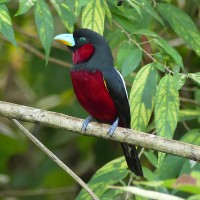 Thailand Birding & Nature FULL - Check out Island of Wonder: Birds & Nature of Sri Lanka!February 17 - March 7, 2026
Thailand Birding & Nature FULL - Check out Island of Wonder: Birds & Nature of Sri Lanka!February 17 - March 7, 2026
-
Essential Information +
Pace & Protocols +
Packing List +
Suggested Reading List +
Useful Links +
Photo credits: Banners: Wreathed Hornbill (Mary Simmons) Thumbnails: Banded Broadbill (NJ Stock), Oriental Bay Owl (NJ Stock), Orange-breasted Trogon (NJ Stock), Green Broadbill (NJ Stock), Red-bearded Bee-eater (NJ Stock), Oriental Pied Hornbill (NJ Stock), Indigo Flycatcher (NJ Stock), Javan Banded Pitta (NJ Stock)


